Related Research Articles
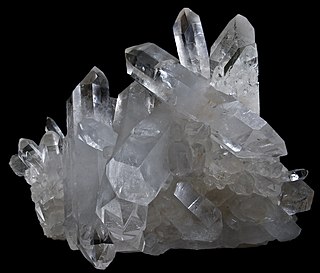
Quartz is a hard, crystalline mineral composed of silica (silicon dioxide). The atoms are linked in a continuous framework of SiO4 silicon–oxygen tetrahedra, with each oxygen being shared between two tetrahedra, giving an overall chemical formula of SiO2. Quartz is, therefore, classified structurally as a framework silicate mineral and compositionally as an oxide mineral. Quartz is the second most abundant mineral in Earth's continental crust, behind feldspar.
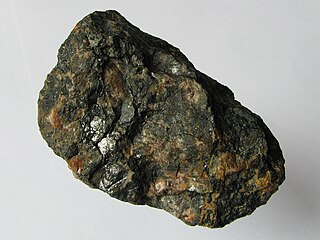
Coffinite is a uranium-bearing silicate mineral with formula: U(SiO4)1−x(OH)4x.
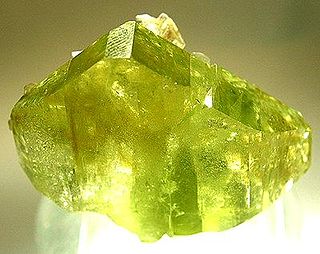
Brazilianite, whose name derives from its country of origin, Brazil, is a typically yellow-green phosphate mineral, most commonly found in phosphate-rich pegmatites.

Xenotime is a rare-earth phosphate mineral, the major component of which is yttrium orthophosphate (YPO4). It forms a solid solution series with chernovite-(Y) (YAsO4) and therefore may contain trace impurities of arsenic, as well as silicon dioxide and calcium. The rare-earth elements dysprosium, erbium, terbium and ytterbium, as well as metal elements such as thorium and uranium (all replacing yttrium) are the expressive secondary components of xenotime. Due to uranium and thorium impurities, some xenotime specimens may be weakly to strongly radioactive. Lithiophyllite, monazite and purpurite are sometimes grouped with xenotime in the informal "anhydrous phosphates" group. Xenotime is used chiefly as a source of yttrium and heavy lanthanide metals (dysprosium, ytterbium, erbium and gadolinium). Occasionally, gemstones are also cut from the finest xenotime crystals.

Lemhi Pass is a high mountain pass in the Beaverhead Mountains, part of the Bitterroot Range in the Rocky Mountains and within Salmon-Challis National Forest. The pass lies on the Montana-Idaho border on the Continental Divide, at an elevation of 7,373 feet (2,247 m) above sea level. It is accessed via Lemhi Pass Road in Montana, and the Lewis and Clark Highway in Idaho, both gravel roads. Warm Springs Road, which roughly follows the divide in Montana, passes just west of the pass's high point.
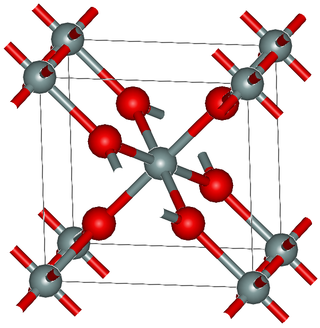
Stishovite is an extremely hard, dense tetragonal form (polymorph) of silicon dioxide. It is very rare on the Earth's surface; however, it may be a predominant form of silicon dioxide in the Earth, especially in the lower mantle.

Allanite (also called orthite) is a sorosilicate group of minerals within the broader epidote group that contain a significant amount of rare-earth elements. The mineral occurs mainly in metamorphosed clay-rich sediments and felsic igneous rocks. It has the general formula A2M3Si3O12[OH], where the A sites can contain large cations such as Ca2+, Sr2+, and rare-earth elements, and the M sites admit Al3+, Fe3+, Mn3+, Fe2+, or Mg2+ among others. However, a large amount of additional elements, including Th, U, Be, Zr, P, Ba, Cr and others may be present in the mineral. The International Mineralogical Association lists four minerals in the allanite group, each recognized as a unique mineral: allanite-(Ce), allanite-(La), allanite-(Nd), and allanite-(Y), depending on the dominant rare earth present: cerium, lanthanum, neodymium or yttrium.
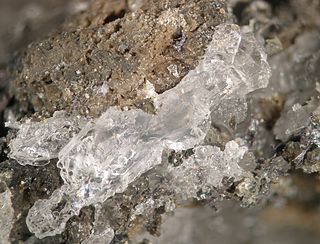
Evenkite is a rare hydrocarbon mineral with formula C24H50; specifically, H3C–(CH2)22–CH3, the alkane n-tetracosane. It occurs as very soft (Mohs hardness 1) transparent crystals, colorless to yellow, with a waxy luster. The softness is a characteristic of crystalline long-chain alkanes, which are the main constituents of paraffin wax.

Carpathite is a very rare hydrocarbon mineral, consisting of exceptionally pure coronene (C24H12), a polycyclic aromatic hydrocarbon. The name has been spelled karpatite and the mineral was improperly renamed pendletonite.

Dollaseite-(Ce) is a sorosilicate end-member epidote rare-earth mineral which was discovered by Per Geijer (1927) in the Ostanmossa mine, Norberg district, Sweden. Dollaseite-(Ce), although not very well known, is part of a broad epidote group of minerals which are primarily silicates, the most abundant type of minerals on earth. Dollaseite-(Ce) forms as dark-brown subhedral crystals primarily in Swedish mines. With the ideal chemical formula, CaREE3+
Mg
2AlSi
3O
11,(OH)F, dollaseite-(Ce) can be partially identified by its content of the rare earth element cerium.

Wakefieldite is an uncommon rare-earth element vanadate mineral. There are four main types described of wakefieldite- wakefieldite-(La), wakefieldite-(Ce), wakefieldite-(Nd), and wakefieldite-(Y), depending upon the dominant rare-earth metal ion present. Wakefieldite has a Mohs hardness ranging from 4 to 5. Wakefieldite forms crystals of tetragonal structure. In terms of crystal structure, it is the vanadate analog of the rare-earth phosphate mineral xenotime. Unlike xenotime, it is more favorable for wakefieldite to contain the lighter rare-earth elements over the heavier ones. Due to the lanthanide contraction, the heavier rare earths have smaller ionic radii than the lighter ones. When the phosphate anion is replaced by the larger vanadate anion, the tetragonal crystal system preferentially accommodates the larger light rare-earth elements.
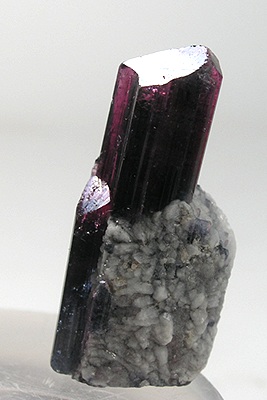
Fluor-liddicoatite is a rare member of the tourmaline group of minerals, elbaite subgroup, and the theoretical calcium endmember of the elbaite-fluor-liddicoatite series; the pure end-member has not yet been found in nature. Fluor-liddicoatite is indistinguishable from elbaite by X-ray diffraction techniques. It forms a series with elbaite and probably also with olenite. Liddiocoatite is currently a non-approved mineral name, but Aurisicchio et al. (1999) and Breaks et al. (2008) found OH-dominant species. Formulae are
Thor Lake is a deposit of rare metals located in the Blachford Lake intrusive complex. It is situated 5 km north of the Hearne Channel of Great Slave Lake, Northwest Territories, Canada, approximately 100 kilometers east-southeast of the capital city of Yellowknife. Geologically located on the Canadian Shield it is mostly composed of peralkaline syenite. The Blatchford Lake complex was created in the early Proterozoic, 2.14 Ga ago. The deposit is divided in several sub-structures. In a small zone at the northern edge of the syenite, the T-Zone, minerals like bastnäsite, phenakite and xenotime can be found.

Ferrokentbrooksite is a moderately rare mineral of the eudialyte group, with formula Na15Ca6(Fe,Mn)3Zr3NbSi25O73(O,OH,H2O)3(Cl,F,OH)2. The original formula was extended form to show the presence of cyclic silicate groups and presence of silicon at the M4 site, according to the nomenclature of eudialyte group. As suggested by its name, it is the (ferrous) iron analogue of kentbrooksite. When compared to the latter, it is also chlorine-dominant instead of being fluorine-dominant. The original (holotype) material is also relatively enriched in rare earth elements, including cerium and yttrium.
Oneillite is a rare mineral of the eudialyte group with the chemical formula Na15Ca3Mn3Fe2+3Zr3NbSiO(Si3O9)2(Si9O27)2(O,OH,H2O)3(OH,Cl)2. The formula is based on the original one but extended to show the presence of cyclic silicate groups and domination of Si at the M4 site. The mineral has lowered symmetry (space group R3, instead of more specific for the group R3m one) due to Ca-Mn ordering. Similar feature is displayed by some other eudialyte-group members: aqualite, labyrinthite, raslakite, and voronkovite. Oneillite is strongly enriched in rare earth elements (REE, mainly cerium), but REE do not dominate any of its sites.
Bijvoetite-(Y) is a very rare rare-earth and uranium mineral with the formula (Y,REE)8(UO2)16(CO3)16O8(OH)8·39H2O. When compared to the original description, the formula of bijvoetite-(Y) was changed in the course of crystal structure redefinition. Bijvoetite-(Y) is an example of natural salts containing both uranium and yttrium, the other examples being kamotoite-(Y) and sejkoraite-(Y). Bijvoetite-(Y) comes from Shinkolobwe deposit in Republic of Congo, which is famous for rare uranium minerals. The other interesting rare-earth-bearing uranium mineral, associated with bijvoetite-(Y), is lepersonnite-(Gd).

Lepersonnite-(Gd) is a very rare-earth element and uranium mineral with the chemical formula Ca(Gd,Dy)2(UO2)24(SiO4)4(CO3)8(OH)24·48H2O. It occurs with bijvoetite-(Y) in the Shinkolobwe deposit in the Democratic Republic of the Congo, famous for rare uranium minerals. It was the first confirmed mineral with essential gadolinium and remained the only gadolinium dominant species until the description of Monazite-(Gd) in 2023.
Florencite-(Sm) is a very rare mineral of the plumbogummite group (alunite supergroup) with simplified formula SmAl3(PO4)2(OH)6. Samarium in florencite-(Sm) is substituted by other rare earth elements, mostly neodymium. It does not form separate crystals, but is found as zones in florencite-(Ce), which is cerium-dominant member of the plumbogummite group. Florencite-(Sm) is also a samarium-analogue of florencite-(La) (lanthanum-dominant) and waylandite (bismuth-dominant), both being aluminium-rich minerals.
Nuragheite is a rare natural thorium molybdate, formula Th(MoO4)2·H2O, discovered in Su Seinargiu, Sarroch, Cagliari, Sardegna, Italy. This locality is also a place of discovery of the other thorium molybdate - ichnusaite, which is a trihydrate.
Barbara Dutrow is an American geologist who is the Adolphe G. Gueymard Professor of Geology at Louisiana State University. Dutrow wrote the textbook Manual of Mineral Science. She was elected President of the Geological Society of America in 2021.
References
- 1 2 Page Xenotime-(Gd): Mineral information, data and localities on "mindat.org". Hudson Institute of Mineralogy . Retrieved 2024-12-27.
- ↑ Ondrejka M, Uher P, Ferenc S, Milovska S, Mikus T, Molnarova A, Skoda R, Kopacik R, Bacik P (2023-04-03). "Gadolinium-dominant monazite and xenotime: Selective hydrothermal enrichment of middle REE during low-temperature alteration of uraninite, brannerite, and fluorapatite (the Zimná Voda REE-U-Au quartz vein, Western Carpathians, Slovakia)". American Mineralogist. 108 (4): 754–768. doi:10.2138/am-2022-8418 . Retrieved 2025-01-01.
- ↑ Olds TA, Emproto C (2024-03-27). "New Mineral Names". American Mineralogist. 109 (4): 799–802. Bibcode:2024MinM...88..613O. doi:10.2138/am-2024-NMN10949 . Retrieved 2024-12-27.
- 1 2 Ondrejka M, Bacik P, Majzlan J, Uher P, Ferenc S, Mikus T, Stevko M, Caplovicova M, Milovska S, Molnarova A, Rössler C, Matthes C (2024-11-14). "Xenotime-(Gd), a new Gd-dominant mineral of the xenotime group from the Zimná Voda REE–U–Au quartz vein, Prakovce, Western Carpathians, Slovakia". Mineralogical Magazine. 88 (5): 613–622. Bibcode:2024MinM...88..613O. doi:10.1180/mgm.2024.62 . Retrieved 2024-12-27.